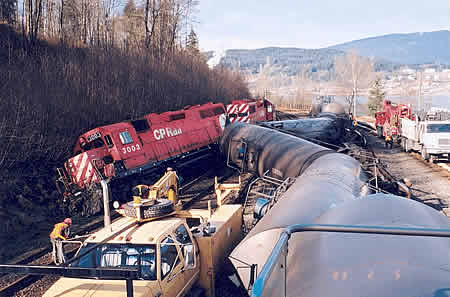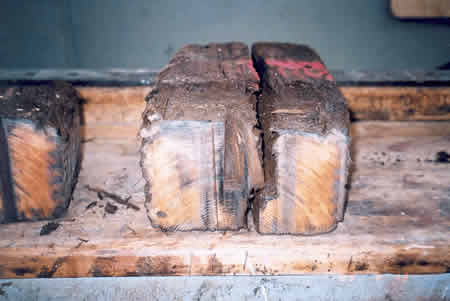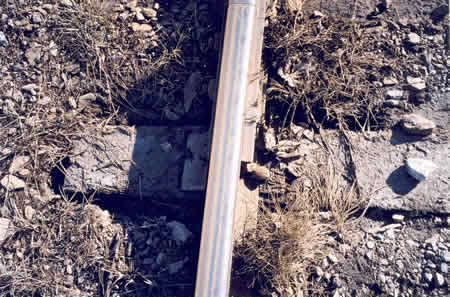Derailment and collision
Canadian Pacific Railway
Train No. 771-009
and
Road Switcher RS-8
Mile 116.95, Cascade Subdivision
Port Moody, British Columbia
The Transportation Safety Board of Canada (TSB) investigated this occurrence for the purpose of advancing transportation safety. It is not the function of the Board to assign fault or determine civil or criminal liability. This report is not created for use in the context of legal, disciplinary or other proceedings. See Ownership and use of content. Masculine pronouns and position titles may be used to signify all genders to comply with the Canadian Transportation Accident Investigation and Safety Board Act (S.C. 1989, c. 3).
Summary
On 05 February 2003, at 0040 Pacific standard time, westward Canadian Pacific Railway freight train 771-009, proceeding along track G-5, Pacific Coast Terminals, at Port Moody, British Columbia, derailed seven loaded tank cars containing glycol. The derailed cars jackknifed southward and fouled the north and south main tracks at Mile 116.95 of the Cascade Subdivision. A second train, road switcher RS-8, proceeding eastward on the south main track, collided with two of the derailed cars. Two tank cars were breached, spilling about 14 000 gallons of glycol (64 000 litres), most of which entered Burrard Inlet. The derailment occurred in an industrial area. There were minor injuries to the RS-8 train crew. There was minimal impact to the environment.
Ce rapport est également disponible en français.
Factual information
On the morning of 05 February 2003, unit glycol train 771-009 (train 771), consisting of 73 loads, weighing 9574 tons and measuring 4028 feet in length, was proceeding westward on Pacific Coast Terminals (PCT) yard track G-5, situated north of the main tracks of the Cascade Subdivision. At approximately 0040 Pacific standard time,Footnote 1 train 771 experienced an in-train emergency air brake application when the train's lead engine was opposite Mile 117.10. A second train, road switcher RS-8, operating light engines, was travelling eastward at a speed of 40 mph on the south main track of the Cascade Subdivision. The locomotive engineer of train 771 initiated a radio broadcast to Canadian Pacific Railway (CPR) RS-8, indicating that train 771 had gone into emergency and might be derailed foul of the main tracks. The locomotive engineer of CPR RS-8, upon hearing the radio transmission from train 771, initiated an independent air brake application in an effort to slow his locomotives. Upon seeing that derailed cars had fouled the north and south main tracks, the locomotive engineer of CPR RS-8 initiated an emergency air brake application.
The lead locomotive on CPR RS-8, CP 3003, struck tank car AOUX 5045, the eighth car in the train 771 consist, which was on its side and had fouled the south main track. As a result of the collision, locomotive CP 3003 derailed to the south side of the south main track and came to rest upright in a ditch. The locomotive engineer and conductor of train RS-8 sustained minor, non-life-threatening injuries.
Following the collision, the locomotive engineer of train 771 made an emergency broadcast on the train standby channel while the conductor of train 771 assisted the train crew of train RS-8. The conductor and crew from RS-8 evacuated the immediate area, because they were concerned about the potential hazard from the contents of the tank cars.
Of the seven cars that derailed, six tank cars were extensively damaged and one tank car sustained minimal damage. Tank cars AOUX 5045 and EOGX 4151 had their tank heads punctured and lost half their loads, approximately 14 000 gallons of glycol, a non-regulated commodity. A total of four of the tank cars were damaged beyond repair. The lead locomotive on RS-8, CP 3003, sustained minor damage. There was no fuel loss from the locomotives.
Examination of the derailed cars at the site did not identify any equipment deficiency in the cars that could have caused or contributed to the derailment.
The weather at the time of the derailment was clear and the temperature was 5°C.
Examination of the event recorder data for train 771 indicates that the train was proceeding westward at 9 mph when the derailment occurred. The train speed was 5.8 mph when the in-train emergency brake application occurred at 0040:42. The lead locomotive of train 771 stopped at Mile 117.10.
Event recorder data for road switcher RS-8 indicates that at 0040:52 the train was proceeding eastward at 40 mph when an independent brake application was made. At 0041:16, while travelling at 30 mph, an emergency brake application was made. RS-8 came to rest at 0041:28. The speed of RS-8 at the time of collision was approximately 20 mph.
Train movements on the Cascade Subdivision within the Vancouver Terminal are governed by the Centralized Traffic Control system and supervised by a rail traffic controller located in Calgary, Alberta. The authorized train speed on the south main track between Mile 116.1 and Mile 118.8 is 40 mph for freight trains and 45 mph for passenger trains.
Train movements in track G-5 are governed by Canadian Rail Operating Rules Rule 105, and supervised locally. Movements in this territory are required to be made at a speed that will permit stopping within half the range of vision and not exceeding 15 mph.
The point of derailment (POD) was on track G-5 located north of the north track, opposite Mile 116.95 of the Cascade Subdivision, and beside the PCT ship loader base. The loader base is surrounded by asphalt approximately 50 feet in length and parallel to track G-5. Drainage along this asphalt was impeded, which had resulted in a soft spot in the track.
The north rail had subsided and created a reverse cross-level condition. This track condition resulted in a weight shift of rail cars as each wheel passed over the soft track, with the gauge progressively widening under the loads. The track gauge measured at the POD under static conditions was 58 1/4 inches (1 3/4 inches wide). Markings on the rail and ties indicated that the car travelled with the one wheel in a derailed state for approximately 900 feet, at which time the car dug into the subgrade causing two cars to jackknife to the south across the north and south main tracks.
Track G-5 was constructed on fill along the south shore of Burrard Inlet. This track parallels the north and south main tracks. The track centre distance between track G-5 and the adjacent north main track was 15 feet. The track is on a four-degree, left-hand curve and is level through the derailment area. The PCT tracks and terminal are located to the north of track G-5. In 1995, track G-5 was realigned to facilitate double tracking to accommodate the operation of the West Coast Express (WCE) commuter passenger service. In 1998, approximately 1.1 miles of 100-pound rail at the east end of track G-5 was relaid, with 115-pound continuous welded rail (CWR), due to an excessive number of rail failures. The remaining portion of 100-pound rail in track G-5 (4200 feet) was scheduled to be relaid with 115-pound CWR in 2004.
The 100-pound rail in the area of the derailment consisted of 39 feet of partly worn 100-pound RE-HFFootnote 2 rail manufactured by Algoma and rolled in 1943. The vertical head wear on the north rail was between 1/8 and 3/8 inch, and the vertical head wear on the south rail was between 1/8 and 3/16 inch. The flange wear was negligible. The rails were connected by 24-inch joint bars. Tie plates were 100-pound single-shouldered. Approximately 1 per cent of the plates were either bent or broken at the gauge side shoulder and were corroded from the combination of sulphur and sea air. The rail was fastened to No. 1 treated track ties with two track spikes on the gauge side and one spike on the field side at each plate. Examination of the track ties in the area of the soft track indicated that the ties were in poor condition, with tie plates cut into the field side as a result of the weight shift of the loaded rail cars (see Photos 2 and 3). Deformation in the spike holes indicated that there was lateral movement and the deteriorated ties could not hold the gauge within accepted tolerances.
Rail anchors were in place at every third tie in the jointed section of track and every second tie on the CWR portion of track. The ballast consisted of crushed limestone and was fouled with fines (see Photo 3).
Except for isolated soft spots where pumping occurred and the location where wide gauge developed, the track was generally in good condition.
Before the derailment, track G-5 was last inspected on 18 November 2002, during a joint bar inspection by track maintenance forces, and no defects were noted. There were no other records of inspections on this track. Access to carry out detailed walking inspections of this track was limited because rail cars were constantly stored on the track; as a result, deficiencies and spot maintenance requirements were not detected. Railway personnel indicated that cursory inspections had been performed at various times, but no record had been kept.
CPR Standard Practice Circular 32 and the Railway Track Safety Rules, which are approved by the Minister of Transport, require that non-main tracks and sidings must be inspected monthly, with intervals of at least 20 calendar days between inspections. The investigation determined that inspections on track G-5 and other tracks parallelling the main tracks were not carried out in accordance with these criteria.
On 21 November 2002, a rail flaw detection car tested track G-5 and found two head web separations. These two rails were found in the vicinity of the POD. They were replaced, but there was no indication of any other track deficiencies at that time. Track G-5 was tested by the flaw detection car twice in 2002, and three times in 2001. The track evaluation car did not test the track geometry of track G-5 at any time, and there was no regulatory requirement for such a test on that track.
There had been no out-of-face or spot surfacing carried out on track G-5 in the past two years. Pockets of soft grade formed over a period of time but had not been corrected, nor had they been detected by routine inspections. Due to the large volume of rail cars being moved and stored in track G-5, there were no provisions made for detailed inspections or corrective maintenance work. Broken rails and joint bars were replaced as required, but there were no tie renewals, and no gauging or surfacing had been performed since the relocation program in 1995 to accommodate the WCE.
Because of the glycol spill with this occurrence, environmental consultants were immediately contracted by CPR, and they conducted water testing over an extended period. Water samples were taken at various locations. All testing determined that the risks to public health were minimal. The responsible authorities, upon completion of site surveys, determined that there was minimal impact to the inlet's ecosystem.
A hazardous materials response team from the city of Port Moody was deployed to the accident site, along with environmental contractors and a CEDA emergency response team, which had been contracted by the railway.
Analysis
There is no information to indicate that the train operation or the mechanical condition of the equipment for trains 771-009 or RS-8 contributed to the accident. The derailment occurred when the rail spread under the load of the train.
The condition of the ties and fastenings clearly indicated that the integrity of the track structure of track G-5 had been compromised. This condition rendered the track gauge susceptible to widening under the load of a passing train.
The derailment was initiated when the lateral force of the train on the rail caused the rail to spread sufficiently to allow the wheels to leave the track.
The wide gauge condition of the track at the point of derailment was likely difficult to detect because it would have only occurred when the track was subject to the heavy load of a train.
The section of track where the derailment occurred had not been tested by the track evaluation car. If the track had been tested, the likelihood of a wide gauge condition going undetected would have been greatly reduced.
Track G-5 had become an integral part of the railway's operation at Port Moody, particularly with respect to the handling of glycol trains, yet the inspection and maintenance required to ensure the integrity of this track was not performed. The risks posed by the unchecked deterioration of this heavily used track were increased because of its location adjacent to the double main tracks of the Cascade Subdivision and the fact that as many as 10 passenger trains passed by this location each day.
The railway immediately recognized the risk to employees, first responders, the local population, and the environment associated with the release of such a large quantity of glycol. CPR's response and that of agencies charged with public and environmental safety was timely, effective, and comprehensive.
Findings
Findings as to causes and contributing factors
- The train derailed because of a wide gauge condition at the point of derailment.
- The widening gauge may have been visible only under the heavy load of a train, thus making it difficult to identify. Broken ties and displaced tie plates, however, were clear indications of more serious track conditions that did not lead to corrective action.
- The deteriorated track conditions went undetected during regular and random inspections. These inspections were not carried out in accordance with CPR Standard Practice Circular 32.
Finding as to risks
- The risks posed by the unchecked deterioration of this heavily used track were increased because of its location adjacent to the double main tracks of the Cascade Subdivision and the fact that as many as 10 passenger trains passed by this location each day.
Other finding
- The railway's response and that of agencies charged with public and environmental safety was timely, effective, and comprehensive.
Safety action taken
Canadian Pacific Railway indicated that the following actions have been taken:
- A total of 450 ties were changed out on track G-5.
- Track G-5 was re-surfaced.
- A monthly inspection of the drainage adjacent to the Pacific Coast Terminals ship loader has been established.
- A local job aid, in the form of an inspection checklist, has been developed for all "other than main tracks" on the Vancouver Service Area.
- Approximately 4200 linear feet of 136 pound relay continuous welded rail was installed in the west portion of track G-5, which eliminated all of the 100-pound jointed rail in the track.
This report concludes the Transportation Safety Board's investigation into this occurrence. Consequently, the Board authorized the release of this report on .


